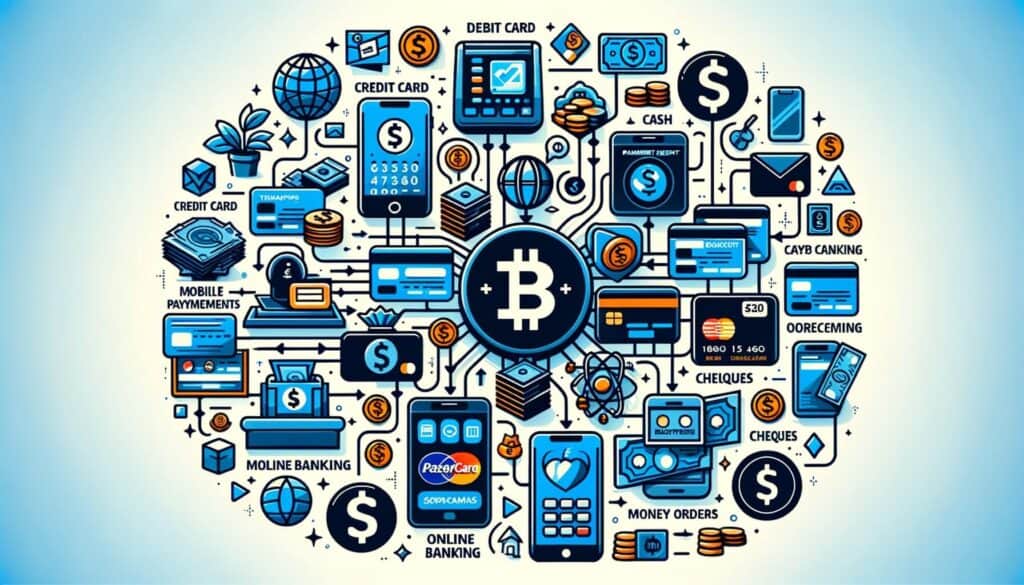
By Catharine Proctor April 2, 2025
In today’s digital age, payment processing has become an integral part of our daily lives. Whether we are shopping online, paying bills, or making in-store purchases, understanding how payment processing works is crucial. Payment processing refers to the entire process of authorizing, capturing, and settling a payment transaction between a customer and a merchant.
This comprehensive guide will take you through the various aspects of payment processing, from the role of payment gateways to security measures and future trends.
The Role of Payment Gateways in the Process

Payment gateways play a vital role in the payment processing ecosystem. They act as a bridge between the merchant’s website or point-of-sale system and the payment networks. When a customer initiates a payment, the payment gateway securely transmits the transaction details to the payment processor.
The payment processor then communicates with the customer’s bank to verify the availability of funds and authenticate the transaction. Once the transaction is approved, the payment gateway sends the authorization back to the merchant, allowing them to complete the sale.
Step-by-Step Guide: How a Payment Transaction is Processed

To understand the intricacies of payment processing, let’s walk through the step-by-step process of a typical payment transaction. The process begins when a customer selects their desired products or services and proceeds to the checkout page. Here, they enter their payment information, such as credit card details or bank account information. The payment gateway encrypts this sensitive data to ensure its security during transmission.
Next, the payment gateway sends the encrypted payment information to the payment processor. The payment processor then forwards this data to the appropriate payment network, such as Visa or Mastercard. The payment network routes the transaction to the customer’s bank for authorization. The bank verifies the customer’s account balance and checks for any suspicious activity. If the transaction is approved, the bank sends an authorization code back to the payment processor.
Once the payment processor receives the authorization code, it relays this information to the payment gateway. The payment gateway then notifies the merchant that the transaction has been approved. At this point, the merchant can proceed with fulfilling the customer’s order. The payment processor also initiates the settlement process, where the funds are transferred from the customer’s bank to the merchant’s account.
Different Types of Payment Methods and their Processing

Payment processing supports various payment methods, each with its own unique processing requirements. Credit and debit cards are the most common payment methods, and they follow a similar processing flow. However, there are also alternative payment methods, such as digital wallets, bank transfers, and mobile payments, which have their own distinct processing mechanisms.
When a customer pays with a credit or debit card, the payment processor communicates with the card network to authorize the transaction. The card network then contacts the customer’s bank to verify the availability of funds. If the transaction is approved, the funds are transferred from the customer’s account to the merchant’s account during the settlement process.
Digital wallets, such as PayPal or Apple Pay, have gained popularity in recent years. These wallets store the customer’s payment information securely and allow for quick and convenient transactions. When a customer pays with a digital wallet, the payment gateway communicates with the wallet provider to authorize and process the transaction.
Bank transfers, also known as ACH payments, involve the direct transfer of funds from the customer’s bank account to the merchant’s account. This payment method requires the customer to provide their bank account and routing numbers. The payment processor facilitates the transfer of funds between the banks involved in the transaction.
Mobile payments, enabled by technologies like Near Field Communication (NFC), allow customers to make payments using their smartphones or wearable devices. These payments are processed through contactless payment terminals, which communicate with the payment gateway to authorize and complete the transaction.
Security Measures in Payment Processing: Protecting Customer Data

With the increasing prevalence of online transactions, ensuring the security of customer data has become a top priority for payment processors and merchants. Payment processing systems employ various security measures to protect sensitive information from unauthorized access and fraud.
One of the primary security measures is encryption. Payment gateways use encryption algorithms to convert payment data into an unreadable format during transmission. This ensures that even if the data is intercepted, it cannot be deciphered without the encryption key.
Tokenization is another security technique used in payment processing. It involves replacing sensitive payment data, such as credit card numbers, with unique tokens. These tokens are meaningless to anyone who does not have access to the tokenization system. This way, even if a hacker gains access to the tokenized data, they cannot use it for fraudulent purposes.
Additionally, payment processors and merchants must comply with the Payment Card Industry Data Security Standard (PCI DSS). This set of security standards ensures that businesses handle customer payment data securely. Compliance with PCI DSS involves implementing measures such as regular security audits, network monitoring, and secure storage of cardholder data.
The Importance of PCI Compliance in Payment Processing
PCI compliance is crucial for any business involved in payment processing. Non-compliance can result in severe consequences, including fines, loss of reputation, and even legal action. By adhering to PCI DSS requirements, businesses demonstrate their commitment to protecting customer data and reducing the risk of data breaches.
PCI compliance involves several key requirements. Businesses must maintain a secure network infrastructure, including firewalls and secure Wi-Fi networks. They must also regularly update their systems and software to protect against vulnerabilities. Additionally, businesses must implement strong access controls, ensuring that only authorized personnel have access to sensitive payment data.
Understanding Settlement and Funding in Payment Processing
Settlement and funding are essential components of the payment processing cycle. Settlement refers to the process of transferring funds from the customer’s bank to the merchant’s account. Once a transaction is authorized, the payment processor initiates the settlement process, which involves debiting the customer’s account and crediting the merchant’s account.
The settlement process typically occurs in batches, where multiple transactions are grouped together for processing. This allows for more efficient handling of transactions and reduces processing costs. Settlement times can vary depending on the payment method and the agreement between the merchant and the payment processor.
Funding, on the other hand, refers to the transfer of funds from the merchant’s account to their designated bank account. After the settlement process is complete, the funds are held in the merchant’s account until they are transferred to their bank account. The frequency of funding depends on the agreement between the merchant and the payment processor, with options ranging from daily to weekly or even monthly.
Chargebacks and Disputes: Dealing with Payment Reversals
Chargebacks and disputes are an inevitable part of payment processing. A chargeback occurs when a customer disputes a transaction and requests a refund from their bank. Chargebacks can happen for various reasons, such as unauthorized transactions, goods not received, or dissatisfaction with the product or service.
When a chargeback is initiated, the payment processor notifies the merchant and debits the disputed amount from their account. The merchant is then given an opportunity to provide evidence to refute the chargeback. If the evidence is compelling, the chargeback may be reversed, and the funds returned to the merchant. However, if the chargeback is upheld, the funds remain with the customer, and the merchant may incur additional fees.
To minimize chargebacks, merchants should maintain clear communication with customers, provide accurate product descriptions, and promptly address any customer concerns or complaints. Implementing fraud detection tools and verifying customer identities can also help prevent unauthorized transactions and reduce the risk of chargebacks.
International Payment Processing: Challenges and Solutions
As businesses expand globally, international payment processing presents unique challenges. Cross-border transactions involve different currencies, regulatory requirements, and cultural considerations. To successfully navigate international payment processing, businesses must address these challenges and implement suitable solutions.
One of the main challenges is currency conversion. When a customer pays in a different currency, the payment processor must convert the amount into the merchant’s preferred currency. Currency conversion rates can fluctuate, impacting the final amount received by the merchant. To mitigate this risk, merchants can use currency conversion services that offer competitive rates and transparent fees.
Another challenge is compliance with international regulations. Each country has its own set of rules and regulations governing payment processing. Businesses must ensure they are aware of and comply with these regulations to avoid legal issues. Partnering with payment processors that have expertise in international payment processing can help businesses navigate these complexities.
Language and cultural differences can also pose challenges in international payment processing. Providing multilingual customer support and localized payment options can enhance the customer experience and increase trust in the payment process. Offering payment methods that are popular in specific regions, such as Alipay in China or iDEAL in the Netherlands, can also improve conversion rates.
Future Trends in Payment Processing: What to Expect
The payment processing landscape is constantly evolving, driven by advancements in technology and changing consumer preferences. Several trends are shaping the future of payment processing, offering new opportunities and challenges for businesses.
One significant trend is the rise of mobile payments. With the increasing adoption of smartphones and wearable devices, consumers are increasingly using their mobile devices to make payments. Mobile payment technologies, such as NFC and mobile wallets, are becoming more prevalent, providing a convenient and secure payment experience.
Another emerging trend is the integration of payment processing with other technologies, such as artificial intelligence (AI) and the Internet of Things (IoT). AI-powered fraud detection systems can analyze vast amounts of data to identify suspicious transactions and prevent fraud. IoT devices, such as connected cars or smart appliances, can enable seamless and secure payments in various contexts.
Cryptocurrencies, such as Bitcoin and Ethereum, are also gaining traction in the payment processing industry. These digital currencies offer fast and secure transactions, with the potential for lower fees compared to traditional payment methods. However, the volatility and regulatory uncertainties surrounding cryptocurrencies present challenges that need to be addressed for widespread adoption.
FAQs
Q1. What is a payment gateway?
Answer: A payment gateway is a technology that facilitates the secure transmission of payment information between the merchant’s website or point-of-sale system and the payment processor.
Q2. How long does it take for a payment transaction to be processed?
Answer: The time it takes for a payment transaction to be processed can vary depending on factors such as the payment method, network connectivity, and the agreement between the merchant and the payment processor. In general, online transactions are processed within seconds, while settlement and funding can take a few days.
Q3. What is PCI compliance?
Answer: PCI compliance refers to adherence to the Payment Card Industry Data Security Standard (PCI DSS), a set of security standards designed to protect customer payment data. Businesses that handle payment card information must comply with these standards to ensure the security of customer data.
Q4. What is a chargeback?
Answer: A chargeback occurs when a customer disputes a transaction and requests a refund from their bank. Chargebacks can happen for various reasons, such as unauthorized transactions or dissatisfaction with the product or service.
Q5. How can businesses minimize chargebacks?
Answer: To minimize chargebacks, businesses should maintain clear communication with customers, provide accurate product descriptions, promptly address customer concerns, and implement fraud detection tools. Verifying customer identities and using secure payment methods can also help prevent unauthorized transactions.
Conclusion
Payment processing is a complex and essential part of modern commerce. Understanding how payment transactions are processed, the role of payment gateways, and the various types of payment methods is crucial for businesses and consumers alike.
Security measures, such as encryption and tokenization, protect customer data, while compliance with PCI standards ensures the secure handling of payment information. Settlement and funding processes ensure the timely transfer of funds between customers and merchants.
Dealing with chargebacks and disputes requires effective communication and fraud prevention strategies. International payment processing presents unique challenges, which can be overcome through currency conversion services, compliance with regulations, and localized payment options.
Looking ahead, mobile payments, integration with emerging technologies, and the rise of cryptocurrencies are shaping the future of payment processing. By staying informed and adapting to these trends, businesses can provide a seamless and secure payment experience for their customers.